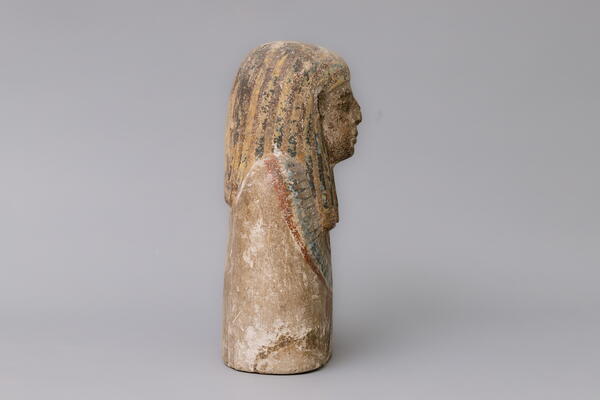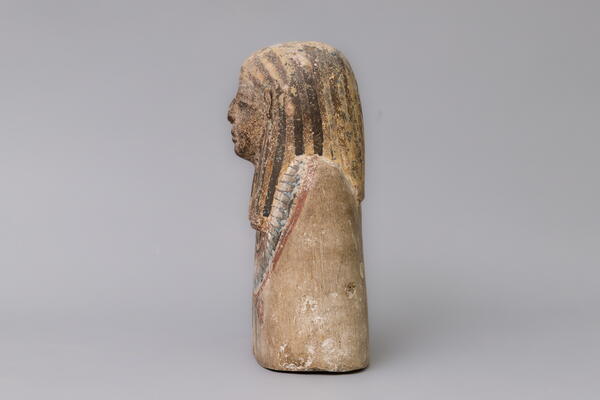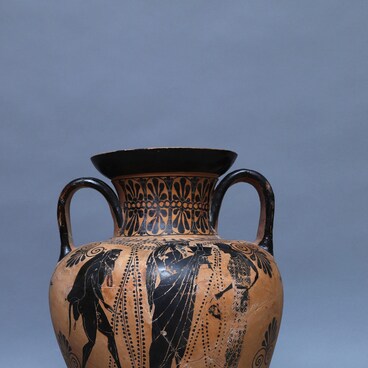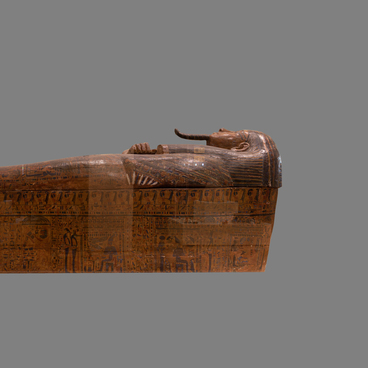Ancestor worship was an essential element of the culture and everyday life of ancient Egypt. It represented the ritual of continuity between the land of the living and the realm of the dead. Ancient Egyptians believed that to ensure the immortality of the deceased, it was necessary to give offerings and say their names aloud. In return, they expected to receive protection and strength to continue the family lineage.
Ritual monuments and ancestral busts were part of this tradition. They were made of wood, clay, or limestone, and if possible decorated in an ornamental and symbolic manner. As a rule, an ancestral bust did not depict a specific deceased relative. It was rather a collective image of a protective ancestor, usually, a woman who symbolized the foremother of the family.
Ancestral busts were small and were set into family altar niches near the entrance to the house. Figurines of the family’s favorite gods and their own objects of worship could also be placed beside the busts. All these sacred items served to protect the house against malevolent spirits. When giving birth, a woman squatted on special birth bricks near the family niche. Infants who died before turning one year old were buried below the house instead of a tomb, to enable their soul to enter the next child born to the household.
The ancestral bust from the collection of the Voronezh Art Museum portrays a woman who, according to ancient Egyptians, embodied the energy of all mothers of the family. Notably, the bust is painted brightly and elaborately while most ancestral busts were rather minimalistic. The woman wears a traditional three-part wig which was typical of the statues created in Upper Egypt. Most Lower Egypt statues have no headwear. This example is unusual because of the bright stripes of the wig and the broad colored necklace.
The foremother’s back features red ribbons of the necklace decorated with flowers and buds of a water lily also known as the lotus. The color is of great importance here, because the white lotus was the symbol of Upper Egypt while the blue lotus represented death. As the flower only rises above the water after sunrise, it was regarded a symbol of rebirth and a connection between the two worlds. This is why the sons of Horus, God of the sky and sun, were often depicted standing on water lilies growing from under the throne of Osiris, the god of the dead. A water lily only reopens at sunrise when light replaces the darkness. Ancient Egyptians considered the lotus to be the symbol of the sun and eternal life.
The closest item to the bust from the Voronezh Museum’s collection is the Gallatin bust which is painted in a similar way. It is named after the American historian and collector Albert Gallatin and is stored at the Metropolitan Museum of Art in New York City.
Ritual monuments and ancestral busts were part of this tradition. They were made of wood, clay, or limestone, and if possible decorated in an ornamental and symbolic manner. As a rule, an ancestral bust did not depict a specific deceased relative. It was rather a collective image of a protective ancestor, usually, a woman who symbolized the foremother of the family.
Ancestral busts were small and were set into family altar niches near the entrance to the house. Figurines of the family’s favorite gods and their own objects of worship could also be placed beside the busts. All these sacred items served to protect the house against malevolent spirits. When giving birth, a woman squatted on special birth bricks near the family niche. Infants who died before turning one year old were buried below the house instead of a tomb, to enable their soul to enter the next child born to the household.
The ancestral bust from the collection of the Voronezh Art Museum portrays a woman who, according to ancient Egyptians, embodied the energy of all mothers of the family. Notably, the bust is painted brightly and elaborately while most ancestral busts were rather minimalistic. The woman wears a traditional three-part wig which was typical of the statues created in Upper Egypt. Most Lower Egypt statues have no headwear. This example is unusual because of the bright stripes of the wig and the broad colored necklace.
The foremother’s back features red ribbons of the necklace decorated with flowers and buds of a water lily also known as the lotus. The color is of great importance here, because the white lotus was the symbol of Upper Egypt while the blue lotus represented death. As the flower only rises above the water after sunrise, it was regarded a symbol of rebirth and a connection between the two worlds. This is why the sons of Horus, God of the sky and sun, were often depicted standing on water lilies growing from under the throne of Osiris, the god of the dead. A water lily only reopens at sunrise when light replaces the darkness. Ancient Egyptians considered the lotus to be the symbol of the sun and eternal life.
The closest item to the bust from the Voronezh Museum’s collection is the Gallatin bust which is painted in a similar way. It is named after the American historian and collector Albert Gallatin and is stored at the Metropolitan Museum of Art in New York City.





